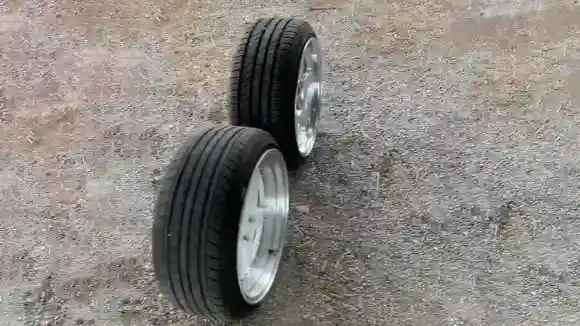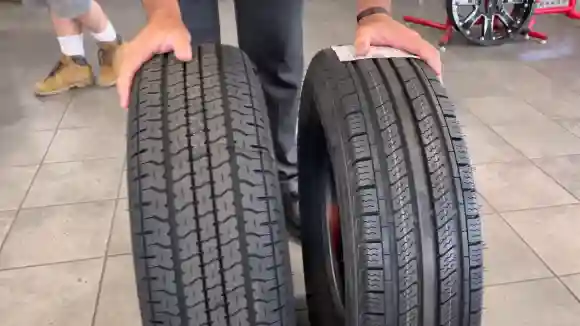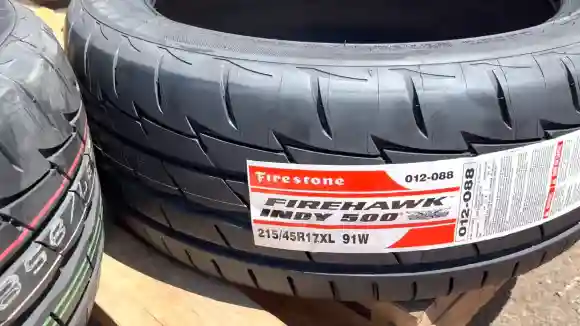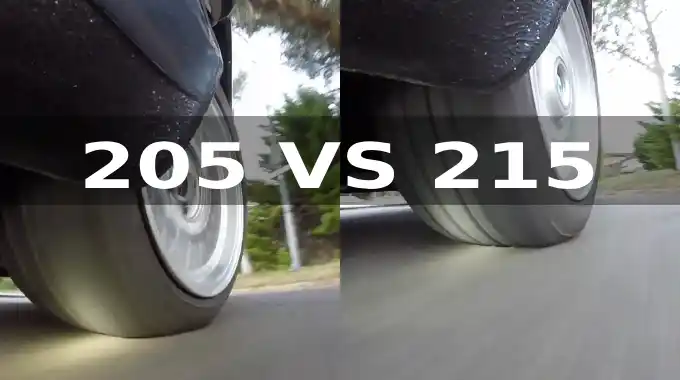Last Updated on July 24, 2023
You’re gearing up for a long haul with your trailer and want to ensure you have the best tires for the job. As you begin your search, you may come across two options: 205 and 215 trailer tires. Although these two tires may seem similar, their key differences can affect your trailer’s performance on the road.
The primary distinction between 205 and 215 trailer tires lies in their width. 205 tires are narrower, measuring approximately 205 millimeters, while the 215 tires are wider, measuring about 215 millimeters. Also, in terms of fuel efficiency, 205 trailer tires have an advantage over the wider 215 tires.
Today we’ll explore the key differences between these two tire options and help you decide which is best for your trailer. So keep reading for detailed information.
205 vs 215 Trailer Tires: Key Differences Explained

If you’re looking for a reliable trailer tire, understand the key differences between 205 and 215:
- Tire Width
- Contact Patch and Traction
- Fuel Efficiency
- Load Capacity
- Handling and Stability
- Rim Compatibility
- Price Range
Tire Width:
With the 215 trailer tire, you’ll enjoy a wider contact patch with the road, providing better stability and handling for your trailer. The extra 10 millimeters in width may seem like little, but it can significantly affect how your trailer performs on the road.
A wider tire means more surface area in contact with the pavement, resulting in better grip and traction. This, in turn, translates to a more responsive and predictable trailer, especially when navigating sharp turns or sudden stops.
However, remember that a wider tire also means greater wind resistance, which can affect your trailer’s fuel efficiency. Additionally, if you’re using a 215 tire on a trailer originally designed for a 205 tire, you might need to make some adjustments to ensure proper fit and clearance.
Contact Patch and Traction:
You’ll feel more confident on wet or snowy roads with 215 tires as they provide better traction and grip, allowing you to navigate through slush and mud while maintaining control easily.
The larger width of the 215 tires creates a broader contact patch with the road surface, increasing the tire’s surface area in contact with the road. This enhanced contact patch allows for better traction and grip on slippery surfaces, making 215 tires the ideal choice for towing in wet or snowy conditions.
To better understand the advantages of a broader contact patch, let’s compare the contact patch of a 205 tire with a 215 tire. The table below shows the contact patch area for both tire widths when loaded with the same weight and air pressure.
| Tire Width | Contact Patch Area |
| 205 | 7.85 sq. in. |
| 215 | 8.54 sq. in. |
Fuel Efficiency:
You can save money on gas by opting for 205 tires with a narrower profile that reduces rolling resistance and gives you more miles per gallon. This is because the 205 tire has a smaller contact patch with the road, which means less friction and less energy required to move the tire forward.
As a result, your vehicle will require less fuel to maintain the same speed and distance, leading to significant savings over time. To further illustrate the benefits of 205 tires for fuel efficiency, consider the following:
- The narrower profile of 205 tires reduces wind resistance, which can also improve fuel economy. This is because the tire creates less drag as it moves through the air, allowing your vehicle to maintain its speed with less effort.
- 205 tires are often lighter than their wider counterparts, which can also contribute to better fuel efficiency. This is because lighter tires require less energy and less fuel consumption.
- By choosing 205 tires for your trailer, you can enjoy improved fuel efficiency without sacrificing performance or safety. These tires are designed to provide excellent traction and stability on the road, ensuring a smooth and safe ride for you and your cargo.
Load Capacity:
If you’re hauling heavy loads on your trailer, it’s important to consider the load-carrying capacity of your tires. This is where 215 trailer tires shine, as they generally have a higher load-carrying capacity than their 205 counterparts.
With a maximum load capacity of 2,200 lbs at 65 psi, 215 trailer tires can handle more weight, making them ideal for heavy-duty hauling. The wider tire width of 215 trailer tires also allows for more even weight distribution, which is crucial when carrying heavier loads.
This means that the weight of the load is distributed more evenly across the tire’s surface area, reducing the risk of uneven wear and tear.
Handling and Stability:

With their wider footprint and larger contact patch, 215 tires provide improved handling and stability, making them a top choice for those who prioritize performance on the road. Here are four reasons why 215 tires offer superior handling and stability:
- Increased Traction: The wider tire width results in a larger contact patch, translating to a better grip on the road. This increased traction allows for better control during turns and maneuvers, reducing the risk of skidding or sliding.
- Enhanced Cornering Ability: The broader tire width also improves the vehicle’s cornering ability by providing more surface area for the tires to grip the road. This allows for smoother and more controlled turns, even at higher speeds.
- Reduced Rolling Resistance: 215 tires have lower rolling resistance than narrower tires, requiring less energy to move forward. This translates to improved fuel efficiency and a smoother ride.
- Better Weight Distribution: With their wider footprint, 215 tires distribute the vehicle’s weight more evenly across the tire’s surface. This results in less stress on the tires and suspension, contributing to a more stable and comfortable ride overall.
Rim Compatibility:
Rim size and load rating compatibility are crucial factors to consider when transitioning from 205 to 215 tires. The rim should be wide enough to accommodate the wider tire, and the load rating should be sufficient to handle the weight of the trailer and its contents.
It is recommended to consult the trailer owner’s manual or a tire professional to determine if the rim is compatible with the 215 tires. To further illustrate the importance of rim compatibility, consider the following table:
| Rim Width (inches) | Recommended Tire Width (inches) |
| 5.5 | 175-205 |
| 6 | 185-215 |
| 6.5 | 195-225 |
| 7 | 205-235 |
Price Range:
When choosing between 205 and 215 trailer tires, you’ll find that the price range can vary depending on the brand and intended use, but generally, 205 tires tend to be more affordable. However, it’s important to remember that price variations can occur based on market conditions, models, and other factors.
205 trailer tires might be the way to go if you’re on a tight budget. Generally, these tires tend to be cheaper than their 215 counterparts. However, ensure that the tire model you choose suits your intended use. Remember that while price is an important factor, it’s not the only one.
Can I use 215 trailer tires instead of 205?
You can use 215 tires instead of 205 tires on your trailer, but remember that the difference in width is only 1cm. Physically, the 215 tires will fit on the rim and tire without any issues. However, you should note that the rolling distance will be a bit shorter for the new tires.
The rolling distance is determined by the tire’s circumference, which is directly related to the tire’s width. As the width of the tire increases, so does the circumference, and the rolling distance becomes longer.
Can I put 205 trailer tires on the front and 215 tires on the rear?
Although it may seem tempting to mount 205 tires on the front axle and 215 on the rear, it would ultimately lead to an uneven weight balance and inconsistent grip on the road due to the difference in width. This would result in one side of the vehicle having a different contact patch with the road, leading to imbalanced handling and braking.
Also, the different tire sizes can affect the vehicle’s suspension and alignment, leading to potential issues with steering and stability. To ensure optimal performance and safety, it’s best to stick with the recommended tire size for your vehicle.
This information can be found in the owner’s manual or the tire placard inside the driver’s side door jamb. If you need to replace a tire, it’s important to replace it with the same size and type of tire as the other three on your vehicle.
Are 205 times more comfortable than 215 tires?
If you want a more comfortable ride, consider going for 205 tires instead of 215. The narrower the tire, the less noise it emits, and this is because narrower tires tend to have larger sidewalls.
This correlation between the aspect ratio and the sidewall size in narrower tires means that they absorb more of the shocks and vibrations from the road, which translates to a more comfortable ride.
To further understand why 205 tires are more comfortable than 215 tires, here are a few things to consider:
- The aspect ratio of a tire affects the size of its sidewall. A lower aspect ratio means a smaller sidewall, which translates to a harder ride, while a larger aspect ratio means a larger sidewall, which translates to a softer ride.
- The width of a tire affects its contact patch with the road. A wider tire has a larger contact patch, which translates to better handling and stability and more road noise and vibration. A narrower tire has a smaller contact patch, translating to less road noise and vibration and less handling and stability.
- The load capacity of a tire affects its comfort level. A tire with a higher load capacity is usually stiffer, contributing to a more difficult ride, while a tire with a lower load capacity is usually softer, which translates to a more comfortable ride.
Do 215 tires distribute the weight better than 205 tires?

Regarding weight distribution, 215 tires have an advantage over 205 tires due to their wider tread. The wider tread allows for better weight distribution across the tire, improving vehicle ride and handling.
This improved weight distribution also allows for better braking as the car can break more evenly, resulting in a shorter stopping distance. To illustrate the difference in weight distribution between 205 and 215 tires, the following table displays the contact patch area for each tire size:
| Tire Size | Contact Patch Area |
| 205 | 235.62 sq. in. |
| 215 | 250.96 sq. in. |
205 or 215 Trailer Tires: Choose the Right One for You
Choosing between 205 and 215 trailer tires ultimately depends on your specific needs and preferences. If you’re looking for a more comfortable ride, the 205 tires can be the good option. But if you’re concerned about weight distribution and handling, the 215 tires may be the way to go.
Always follow manufacturer guidelines and ensure your tires are properly inflated and maintained. Whether you opt for 205 or 215 tires, choose a high-quality brand with the appropriate load rating and ply count for your trailer.
By making an informed decision and properly caring for your tires, you can ensure a safe and efficient towing experience.



